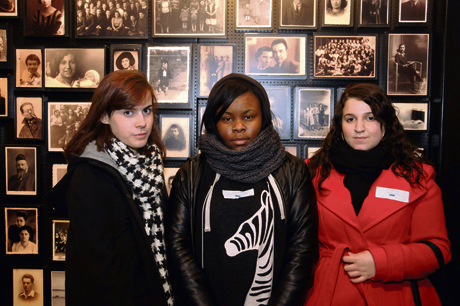Hackney students visit Auschwitz death camps

L-R: Ellen Langford, Chidi Nma Eluwa, (both of Our Lady’s Convent High School), Liz Demetriou, (Haggerston School)
Three students from Hackney visited Auschwitz last month as part of a project designed to teach people about the horrors of the Nazi atrocities.
The students flew to Poland and back on 15 November as part of a day trip organised by the Holocaust Educational Trust, which provides schools with teaching resources and arranges talks with survivors of the Holocaust.
“You get this feeling you’ll see a picture of someone you’ve seen before,” said Liz Demetriou, 18, from Haggerston School, referring to photographs of prisoners and their families. Liz’s philosophy teacher suggested she take part in the project, which saw 200 students and teachers from London shown around the site of some of the worst crimes in human history.
“It was really emotional. I felt numb,” she continued. “When my dad called I couldn’t even speak.” A a story about a baby being thrown from a train carriage was particularly upsetting. “I’ve got three baby brothers,” she said. “It’s just a baby. Why do something like that?”
The HET’s ‘Lessons from Auschwitz Project’ has been running for thirteen years and has taken over 14,000 ‘post-16’ students and teachers to visit Auschwitz. The Trust was founded in 1988 and receives funding from the government.
After their trip, students complete their project by arranging a talk or event in their local community to share their experience as ‘ambassadors’ for the HET.
Liz thinks it is very important that people “visit the place and see it,” because “discrimination is still going on, so people have to understand its relevance today.”
Students were able to visit the only remaining synagogue in the town of Osweicim, home to thousands of Jewish people before the war. Part of the town was renamed Auschwitz by the Nazis, where it is estimated they murdered 1,100,000 to 1,500,000 people in labour and death camps.
The majority of the victims were Jewish, many of whom had been transported from across Europe to the camps. Tens of thousands of Poles were killed along with thousands of others, including Gypsies, homosexuals, and Soviet prisoners of war.
The students were then given a tour of the camps at Auschwitz I, which bares the famous ‘Arbeit Macht Frei’ sign put there by Rudolf Hess and inspired by a similar sign at Dachau, and Auschwitz II (or Auschwitz-Birkenau), which is twenty-five times larger.
Chidi Nma Eluwa, 17, of Our Lady’s Convent High School, wrote a letter on why she wanted to take part, after an older friend had told her it ‘changed her life’. “It was emotional in the sense that I didn’t know how to feel,” she tells me upon returning. “I couldn’t feel angry, because sadness is a slow emotion.”
Chidi says the trip “made me look at everything in a different perspective,” such as crossing the road near her school in Stamford Hill and seeing Jewish people. She says it’s important to learn from history and not be a ‘bystander’, especially when people are suffering in places such as Darfur and Syria.
She said people should “go and visit” themselves, because “reading it you have images in your head,” but it’s the “absence of things” that is so affecting when you are there.
Ellen Langford, 16, also from Our Lady’s Convent High School, said: “We both felt rather sick. It was hard to believe what we had seen.” Ellen said that seeing the train tracks leading to Auschwitz-Birkenau made what happened there ‘real’: “It was hard to place myself. I actually have been where thousands had gone. They never got to walk out.”
She said that while the history is well known, “no-one will be able to appreciate and understand the full story” without going there. “It’s important for everyone to know what went on so the memory doesn’t die out,” she added.
Karen Pollock, Chief Executive of the Holocaust Education Trust, said: “HET’s Lessons from Auschwitz project is such a vital part of our work because it gives students the chance to understand the dangers and potential effects of prejudice and racism today.
“The inspiring work students go on to do in their local areas demonstrates the importance of the visit.”
